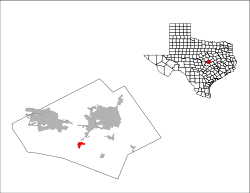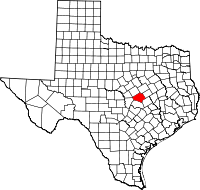Salado, Texas
| Salado, Texas | |
|---|---|
| Village | |
|
Welcome sign in Salado, Texas | |
|
Location of Salado, Texas | |
 | |
| Coordinates: 30°57′19″N 97°32′5″W / 30.95528°N 97.53472°WCoordinates: 30°57′19″N 97°32′5″W / 30.95528°N 97.53472°W | |
| Country | United States |
| State | Texas |
| County | Bell |
| Area | |
| • Total | 2.2 sq mi (5.7 km2) |
| • Land | 2.2 sq mi (5.6 km2) |
| • Water | 0.04 sq mi (0.1 km2) |
| Elevation | 600 ft (183 m) |
| Population (2010) | |
| • Total | 2,126 |
| • Density | 982/sq mi (379.3/km2) |
| Time zone | Central (CST) (UTC-6) |
| • Summer (DST) | CDT (UTC-5) |
| ZIP code | 76571 |
| Area code(s) | 254 |
| FIPS code | 48-64268[1] |
| GNIS feature ID | 1367336[2] |

Salado /səˈleɪdoʊ/ is a village in Bell County, Texas, United States. Salado was first incorporated in 1867 for the sole purpose of building a bridge across Salado Creek. In 2000 the citizens of Salado voted in favor of re-incorporation, before which point it was a census-designated place (CDP). The population of the village was 2,126 at the 2010 census.[3] It is part of the Killeen–Temple–Fort Hood Metropolitan Statistical Area.
The town is home to the Stagecoach Inn, the oldest continuously running hotel in Texas.
History
Archaeological evidence of a paleolithic Native American settlement dating back about 15,500 years, the Buttermilk Creek Complex, has been unearthed in Salado.
The first record of white settlers in the area occurs in 1834 however by 1836 the pioneer settlers abandoned area due to frequent Indian attacks and the invasion by General Santa Anna and the Mexican Army.[4] The first permanent Anglo-American settler at Salado was Archibald Willingham in 1850. In 1852, the Salado Post Office was established. In 1859, the Salado College Joint Stock Company was created by Col. Elijah Sterling Clack Robertson who donated 320 acres north and south of the springs to be broken into lots and form the village of Salado. With the proceeds of the sale going to form Salado College. The college would operate from 1860-1885 and from 1895 to 1913 the former college building was occupied by the Thomas Arnold High School.
From 1866 till 1885, the famous Chisholm Trail cattle drives passed through this area, with the Stagecoach Inn being one of the stops. In 1867, Salado incorporated to build a bridge across Salado Creek. By 1884 the Salado had a population of 900, 7 churches, 14 stores, 2 hotels, 2 blacksmiths, and 3 cotton gins. However after the railroads bypassed Salado to the North and South trade moved away from the town and population began to dwindle, hitting 400 by 1914 and down to 200 by 1950.[5][6]
There are 19 Salado locations listed in the National Register of Historical Places including the George Washington Baines House.
Geography
Salado is located in south-central Bell County at 30°57′19″N 97°32′05″W / 30.955225°N 97.534610°W.[7] Interstate 35 runs through the village, leading north 9 miles (14 km) to Belton, the county seat, and south 23 miles (37 km) to Georgetown.
According to the United States Census Bureau, the village has a total area of 2.2 square miles (5.7 km2), of which 0.04 square miles (0.1 km2), or 2.10%, is water.[3]
Salado is located along the Balcones Fault, which causes the emergence of surface waters. The fault line is also a demarcation line for some species' natural ranges. For example, the California Fan Palm, Washingtonia filifera, occurs strictly west of Salado or the Balcones Fault.
Salado Creek was selected as the first Texas Natural Landmark.
Climate
The climate in this area is characterized by hot, humid summers and generally mild to cool winters. According to the Köppen Climate Classification system, Salado has a humid subtropical climate, abbreviated "Cfa" on climate maps.[8]
Demographics
As of the census[1] of 2000, there were 3,475 people, 1,382 households, and 1,112 families residing in the CDP. The population density was 204.2 people per square mile (78.8/km2). There were 1,465 housing units at an average density of 86.1 per square mile (33.2/km2). The racial makeup of the CDP was 92.37% White, 0.26% African American, 0.63% Native American, 0.60% Asian, 0.06% Pacific Islander, 5.15% from other races, and 0.92% from two or more races. Hispanic or Latino of any race were 8.66% of the population.
There were 1,382 households out of which 29.7% had children under the age of 18 living with them, 72.1% were married couples living together, 6.3% had a female householder with no husband present, and 19.5% were non-families. 16.9% of all households were made up of individuals and 8.7% had someone living alone who was 65 years of age or older. The average household size was 2.51 and the average family size was 2.81.
In the CDP the population was spread out with 22.4% under the age of 18, 5.5% from 18 to 24, 23.0% from 25 to 44, 31.3% from 45 to 64, and 17.9% who were 65 years of age or older. The median age was 44 years. For every 100 females there were 97.0 males. For every 100 females age 18 and over, there were 94.0 males.
The median income for a household in the CDP was $63,646, and the median income for a family was $70,667. Males had a median income of $48,098 versus $26,528 for females. The per capita income for the CDP was $29,685. About 3.0% of families and 3.8% of the population were below the poverty line, including 2.5% of those under age 18 and 4.5% of those age 65 or over.
Education
Salado is served by the Salado Independent School District. Salado schools are quite well known for their UIL academics. The Eagles have had a long series of strong academic teams. Salado is also represented by a long-time winning sports program. Salado High School has won numerous state championships with its golf program, and the baseball team won the 2008 State Championship. Salado High School won the 2008 Lone Star Cup.
The Salado One Act Play (SOAP) Team are the 2010 State 2A UIL One Act Play Champions. Their entry The Balkan Women by Jules Tasca was the target of a group of middle school parents between the Regional and State competitions. A threatened protest was averted after the protestors attended a public performance. The cast and crew went on to represent the district well during the State Competition; Stetson Gilchrest was selected as Best Actor and was presented the 2010 Samuel French Award. Heather Williams, Haley Williams and Bailee Reed were selected as All Star Cast and all 8 members of the chorus were presented with an Honorable Mention All Star Cast Award. Directors J. J. Jonas and Kyra Mann were supported by Student Director Lainey Sirois and Assistant Student director Samantha Yeager. In 2012 Salado High School won first place at the state competition in the 3AAA category. Haley Williams received the Samuel French Award.[9]
Salado College was the first college in Bell County. It operated from 1860 until 1885.
Culture
The Texas Association of Private and Parochial Schools (TAPPS) is headquartered in the Salado Civic Center in downtown Salado.[10][11]
Notable people
- Liz Carpenter, journalist
- James Edward Ferguson, 26th governor of Texas
- Miriam Amanda Ferguson, 29th and 32nd governor of Texas
- Lela and Raymond Howard, an older married couple who disappeared (and were later found dead) and became the basis for a 1998 hit song "The Way" by Fastball
- William Whitaker Reed, one of the first settlers of Bell County and its first sheriff, elected in 1850. The Salado Visitors Center is made in part from his preserved 1850 dogtrot house.[12]
- George Washington Baines- maternal great-grandfather of U.S. President Lyndon Baines Johnson, was a Baptist clergymanwho served briefly as natural science professor and President of Baylor University.
See also
References
- ↑ 1.0 1.1 "American FactFinder". United States Census Bureau. Retrieved 2008-01-31.
- ↑ "US Board on Geographic Names". United States Geological Survey. 2007-10-25. Retrieved 2008-01-31.
- ↑ 3.0 3.1 "Geographic Identifiers: 2010 Demographic Profile Data (G001): Salado village, Texas". U.S. Census Bureau, American Factfinder. Retrieved April 11, 2014.
- ↑ History of Salado
- ↑ Salado History
- ↑ Salado, TX THSA
- ↑ "US Gazetteer files: 2010, 2000, and 1990". United States Census Bureau. 2011-02-12. Retrieved 2011-04-23.
- ↑ Climate Summary for Salado, Texas
- ↑ Texas UIL Website
- ↑ "Administration." Texas Association of Private and Parochial Schools. Retrieved on March 9, 2012. "Texas Association of Private and Parochial Schools 601 North Main P.O. Box 1039 Salado, TX 76571"
- ↑ "Contact Information." Salado Civic Center. Retrieved on March 9, 2012. "Salado Civic Center 601 North Main in Downtown Salado, Texas 76571"
- ↑ Brochure "William Whitaker Reed House", 1850, Visitors Center, Salado, Texas
Further reading
- Felda Davis Shanklin. 1960. Salado, Texas Bell, Belton, Texas
External links
- Salado Chamber of Commerce
- Salado Village Voice, local newspaper
- Salado from the Handbook of Texas Online
| |||||||||||||||||||||||||||||||||||||
